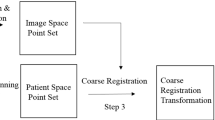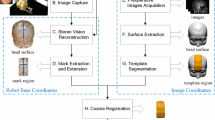Abstract
As image-guided navigation plays an important role in neurosurgery, the spatial registration mapping the pre-operative images with the intra-operative patient position becomes crucial for a high accurate surgical output. Conventional landmark-based registration requires expensive and time-consuming logistic support. Surface-based registration is a plausible alternative due to its simplicity and efficacy. In this paper, we propose a comprehensive framework for surface-based registration in neurosurgical navigation, where Kinect is used to automatically acquire patient’s facial surface in a real time manner. Coherent point drift (CPD) algorithm is employed to register the facial surface with pre-operative images (e.g., computed tomography (CT) or magnetic resonance imaging (MRI)) using a coarse-to-fine scheme. The spatial registration results of 6 volunteers demonstrate that the proposed framework has potential for clinical use.
Similar content being viewed by others
References
Peters T M. Image-guidance for surgical procedures [J]. Physics in Medicine and Biology, 2006, 51(14): R505–R540.
Maurer Jr C R, Maciunas R J, Michael Fitzpatrick J. Registration of head CT images to physical space using a weighted combination of points and surfaces [J]. IEEE Transactions on Medical Imaging, 1998, 17(5): 753–761.
Marmulla R, Hassfeld S, Lüth T, et al. Laserscan-based navigation in cranio-maxillofacial surgery [J]. Journal of Cranio-Maxillofacial Surgery, 2003, 31(5): 267–277.
Hoffmann J, Westendorff C, Leitner C, et al. Validation of 3D-laser surface registration for imageguided cranio-maxillofacial surgery [J]. Journal of Cranio-Maxillofacial Surgery, 2005, 33(1): 13–18.
Eggers G, Mühling J, Marmulla R. Image-topatient registration techniques in head surgery [J]. International Journal of Oral and Maxillofacial Surgery, 2006, 35(12): 1081–1095.
Khoshelham K, Elberink S O. Accuracy and resolution of Kinect depth data for indoor mapping applications [J]. Sensors, 2012, 12(2): 1437–1454.
Berger K, Ruhl K, Schroeder Y, et al. Markerless motion capture using multiple color-depth sensors [C]// Vision Modeling Visualization. Bangor, Wales: Eurographics Association, 2011: 317–324.
Otsu N. A threshold selection method from gray-level histograms [J]. IEEE Transactions on Systems, Man, and Cybernetics, 1979, 9(1): 62–66.
Li H, Shen T, Huang X. Approximately global optimization for robust alignment of generalized shapes [J]. IEEE Transactions on Pattern Analysis and Machine Intelligence, 2011, 33(6): 1116–1131.
Jian B, Vemuri B C. Robust point set registration using Gaussian mixture models [J]. IEEE Transactions on Pattern Analysis and Machine Intelligence, 2011, 33(8): 1633–1645.
Zhang S, Zhan Y, Dewan M, et al. Towards robust and effective shape modeling: Sparse shape composition [J]. Medical Image Analysis, 2012, 16(1): 265–277.
Zhang S, Zhan Y, Cui X, et al. 3D anatomical shape atlas construction using mesh quality preserved deformable models [J]. Computer Vision and Image Understanding, 2013, 117(9): 1061–1071.
Myronenko A, Song X. Point set registration: Coherent point drift [J]. IEEE Transactions on Pattern Analysis and Machine Intelligence, 2010, 32(12): 2262–2275.
Salvi J, Matabosch C, Fofi D, et al. A review of recent range image registration methods with accuracy evaluation [J]. Image and Vision Computing, 2007, 25(5): 578–596.
Hernandez M, Choi J, Medioni G. Laser scan quality 3-D face modeling using a low-cost depth camera [C]// 20th European Signal Processing Conference. Bucharest, Romania: IEEE, 2012: 1995–1999.
Meyer G P, Do M N. Real-time 3D face modeling with a commodity depth camera [C]// 2013 IEEE International Conference on Multimedia and Expo Workshops. San Jose, CA: IEEE, 2013: 1–4.
Author information
Authors and Affiliations
Corresponding author
Additional information
Foundation item: the National Natural Science Foundation of China (Nos. 61190120, 61190124 and 61271318) and the Biomedical Engineering Fund of Shanghai Jiaotong University (No. YG2012ZD06)
Rights and permissions
About this article
Cite this article
Zhang, Lx., Zhang, St., Xie, Hz. et al. Kinect-based automatic spatial registration framework for neurosurgical navigation. J. Shanghai Jiaotong Univ. (Sci.) 19, 617–623 (2014). https://doi.org/10.1007/s12204-014-1550-2
Received:
Published:
Issue Date:
DOI: https://doi.org/10.1007/s12204-014-1550-2




